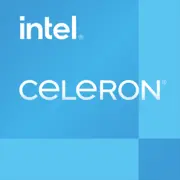Intel Celeron G5920

Intel Celeron G5920: Processore Economico per Compiti Base
Analizziamo le capacità, la compatibilità e gli scenari d'uso del chip dual-core Comet Lake
1. Caratteristiche Principali: Architettura, Processo Tecnologico e Prestazioni
Architettura Comet Lake
Il Celeron G5920 appartiene alla famiglia Comet Lake-S, presentata da Intel nel 2020. Si tratta della 10ª generazione di processori, ma basata su un processo tecnologico obsoleto a 14 nm. Nonostante l'uso ripetuto dello stesso processo, Intel ha ottimizzato l'architettura per aumentare le frequenze — la frequenza di base del G5920 è di 3.5 GHz, mentre il Turbo Boost è assente.
Caratteristiche chiave:
- 2 core / 2 thread — configurazione minima per i compiti moderni.
- Cache L3 — 2 MB — sufficiente per applicazioni semplici, ma non adeguato per il multitasking complesso.
- Grafica Integrata UHD 610 — supporta il 4K tramite HDMI 1.4, ma è poco adatta ai giochi.
- TDP 58 W — consumo energetico moderato, ma superiore a quello di alcuni concorrenti (ad esempio, l'Athlon 3000G ha un TDP di 35 W).
Prestazioni nei test:
- Geekbench 6: 749 (Single-Core), 1248 (Multi-Core). A titolo di confronto: il Pentium Gold G6405 (2C/4T) ottiene circa 900/1800.
- Cinebench R23: Risultati attesi — circa 600-700 punti in multi-threading.
Esempio pratico: In un PC da ufficio con SSD, il Celeron G5920 gestisce Word, Excel e 10+ schede in Chrome, ma potrebbe mostrare dei rallentamenti quando si avvia Zoom insieme al browser.
2. Schede Madri Compatibili
Socket LGA 1200 e Chipset
Il processore utilizza il socket LGA 1200, il che limita la scelta delle schede ai formati:
- H410 / B460 / H470 / Z490 — per Comet Lake.
- H510 / B560 / H570 / Z590 — compatibili dopo l'aggiornamento del BIOS, ma non tutti i produttori forniscono supporto.
Raccomandazioni per la scelta:
- Opzione economica: ASUS Prime H410M-K — scheda di base con HDMI e USB 3.2.
- Per un aggiornamento: MSI B560M PRO-VDH — supporta PCIe 4.0 e memoria più veloce (se si aggiorna il processore in futuro).
Limitazioni:
- I chipset H410/B460 non supportano l'overclocking (ma per Celeron non è rilevante).
- Velocità massima RAM — DDR4-2666 (su H510/B560 può essere superiore, ma il processore limita la frequenza).
3. Memoria Supportata
Tipo di memoria: DDR4-2666 (ufficialmente). DDR5 e LPDDR4x non sono supportati.
Configuraizioni:
- Modalità dual-channel — obbligatoria per migliorare le prestazioni della grafica integrata.
- Quantità massima — 128 GB (ma per Celeron è ragionevole avere 8-16 GB).
Esempio di build: 2 moduli da 4 GB DDR4-2666 (ad esempio, Kingston Fury Beast) forniranno un incremento del 15-20% nei giochi e nel rendering video rispetto alla modalità single-channel.
4. Raccomandazioni per l'Alimentatore
Calcolo della potenza:
- TDP del processore — 58 W.
- Considerando scheda madre, SSD, memoria e raffreddatore: 150-200 W.
- Se si aggiunge una scheda video (ad esempio, GTX 1650), sarà necessario un alimentatore da 350-400 W.
Consigli:
- Scegliere modelli con certificazione 80 Plus Bronze (Be Quiet! System Power 9, Corsair CV450).
- Evitare alimentatori economici non di marca — potrebbero avere performance instabili anche con carichi leggeri.
5. Pro e Contro del Celeron G5920
Pro:
- Prezzo basso (~$50-60) — uno dei processori LGA 1200 più accessibili.
- Efficienza energetica — adatto per PC compatti e sistemi con raffreddamento passivo.
- Grafica integrata — non richiede una scheda video dedicata per l'output video.
Contro:
- 2 core / 2 thread — insufficiente per attività parallele (streaming, montaggio).
- GPU debole — UHD 610 perde contro la Vega 3 (Athlon 3000G) nei giochi.
- Aggiornamento limitato — passare a Core i3/i5 richiederà la sostituzione del raffreddatore a causa dell'aumento del TDP.
6. Scenari d'Utilizzo
Gaming
- Cosa funziona: Minecraft, Dota 2, CS:GO a impostazioni basse (720p, 30-40 FPS).
- Con scheda video dedicata: GTX 1050 Ti o RX 6400 — il processore diventerà un "collo di bottiglia" nei progetti moderni (Cyberpunk 2077, Horizon Zero Dawn).
Compiti di Lavoro
- Adatto per: programmi d'ufficio, email, videochiamate.
- Non adatto per: montaggio 4K, modellazione 3D, lavoro in Blender.
Multimedia
- Pro: decodifica hardware di video VP9 e H.265 — visione di 4K su YouTube.
- Contro: assenza di AV1 — per i servizi di streaming futuri potrebbe essere necessario un aggiornamento.
7. Confronto con i Concorrenti
AMD Athlon 3000G (Zen, 14 nm)
- 2C/4T, Vega 3, TDP 35 W.
- Geekbench 6: ~700 (SC), ~1400 (MC).
- Pro: multi-threading, grafica migliore.
- Contro: socket AM4 obsoleto, più difficile trovare nuove schede.
Intel Pentium Gold G6405 (Comet Lake)
- 2C/4T, UHD 610, TDP 58 W.
- Geekbench 6: ~900 (SC), ~1800 (MC).
- Pro: Hyper-Threading, prezzo a partire da $70.
Conclusione: Il Celeron G5920 perde contro l'Athlon 3000G in multitasking e grafica, ma vince sul prezzo. Per i giochi, è meglio scegliere l'Athlon, per l'ufficio — Celeron.
8. Consigli per l'Assemblaggio
- Scheda madre: non pagare troppo per Z490 — va bene H410.
- Storage: SSD obbligatorio (Crucial BX500 240 GB).
- Raffreddamento: il dissipatore stock è sufficiente, ma per un funzionamento silenzioso sostituirlo con un Deepcool GAMMAXX 200T.
- Case: Mini-ITX (Fractal Design Core 500) per un media center compatto.
9. Conclusione Finale: A Chi Si Adatta il Celeron G5920?
Questo processore è una scelta per:
- PC da ufficio economici — se serve un computer per Word e browser.
- Home Theater — grazie alla decodifica 4K.
- Server entry-level — per archiviazione file o VPN.
Perché proprio lui? Prezzo basso, consumo energetico minimo e prestazioni sufficienti per compiti di base. Tuttavia, per giochi, montaggio o lavoro con AI è meglio considerare Pentium Gold o Ryzen 3.
Di base
Specifiche della CPU
Specifiche della memoria
Specifiche della GPU
Varie
Classifiche
Rispetto ad altre CPU
Condividi sui social media
Oppure linkaci
<a href="https://cputronic.com/it/cpu/intel-celeron-g5920" target="_blank">Intel Celeron G5920</a>